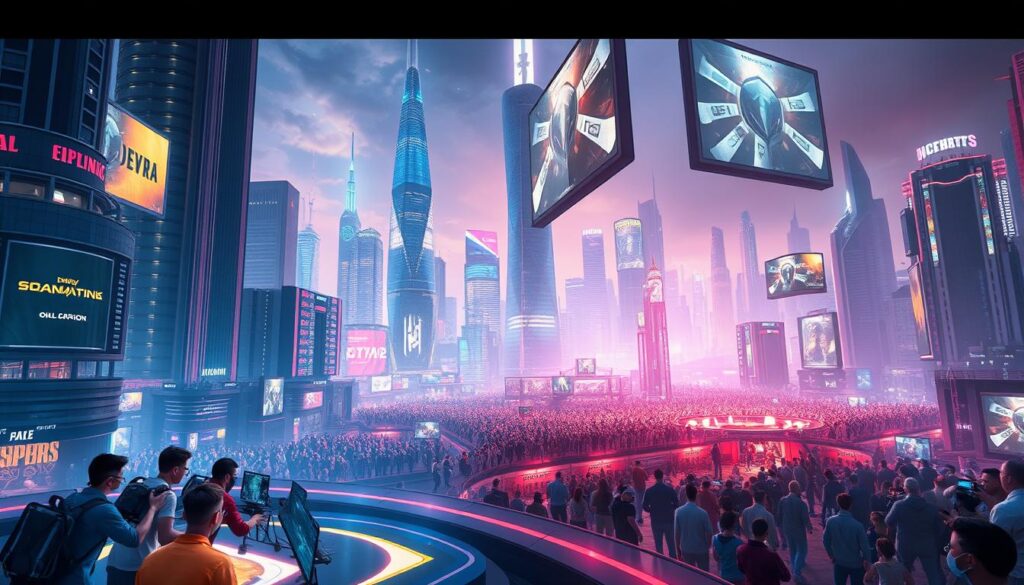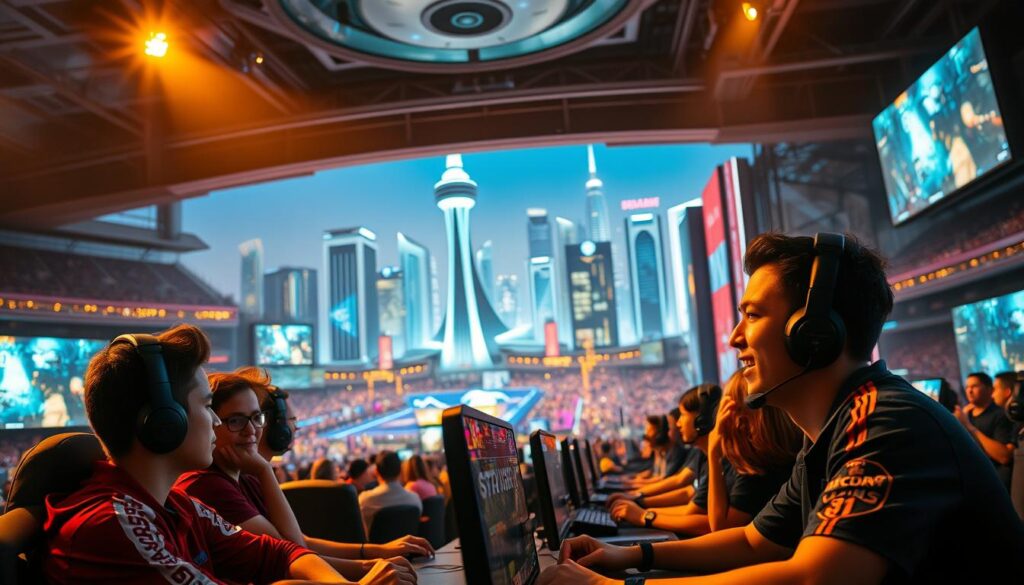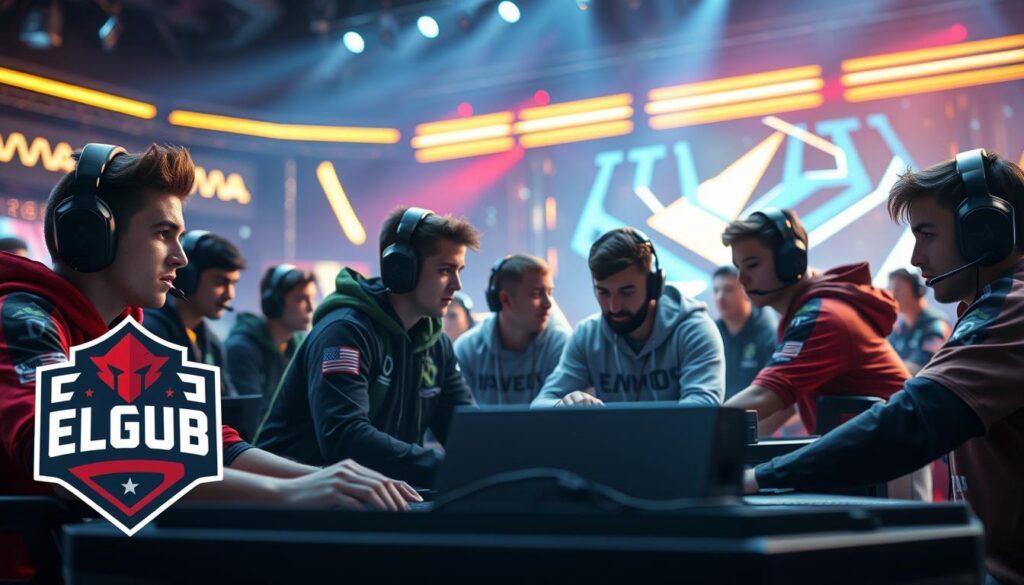Welcome to the digital Colosseum, where 16-year-olds wield controllers like gladiatorial swords. $1.8 billion changes hands faster than a Call of Duty respawn. This arena has grown from basement LAN parties to stadiums with roaring crowds.
Think Major League Baseball’s minor leagues are big? Think again. The competitive gaming sector now outpaces them economically. It’s fueled by a global audience that’ll hit 577 million by 2024. That’s more viewers than the last three Super Bowls combined.
They’re not just watching. They’re buying merch, betting skins, and turning pro gamers into millionaire influencers. Why should Wall Street care about your little brother’s Fortnite obsession? Because the esports economy runs on dopamine hits and Twitch subscriptions.
Nearly 40% of fans are women, 78% are legal drinking age. They’re all part of a machine that turns headshots into hedge funds. This isn’t just playtime – it’s the new American dream with RGB lighting.
The real magic happens where competition meets capitalism. Brands from Red Bull to State Farm now battle for screen time. While college scholarships turn joystick jockeys into student-athletes. Forget “get rich quick” schemes – today’s gold rush happens at 240 frames per second.
Introduction: An Industry Overview
Remember when “gaming culture” was all about trading Pokémon cards? Today, the esports market is huge. It could buy every Charizard and then send them to space with Elon Musk. The growth is amazing.
What started as small competitions now has huge budgets. The League of Legends World Championship had more viewers than the Super Bowl last year. That’s a big deal.
| Metric | Esports (2023) | Traditional Sports |
|---|---|---|
| Global Audience | 532 million | Super Bowl: 113 million |
| Youngest Demographic | 72% under 35 | NFL: 47% under 50 |
| Revenue Streams | Media rights, skins, NFTs | Tickets, merch, ads |
Esports is more than just kids playing games. Mercedes-Benz sponsors Dota 2 teams, and Drake backs 100 Thieves. It’s a big deal.
The esports market is like Wall Street but with RGB lights. It creates overnight millionaires and has its own stock market.
“We’re not just building games anymore. We’re architecting digital colosseums.”
Three big changes explain why esports is booming:
- Streaming platforms make players influencers
- Blockchain lets people own digital items
- Gen Z likes interactive entertainment
Esports didn’t just change entertainment; it became the main event. Next time someone mocks “video game sports,” tell them about Fortnite’s Travis Scott concert. It had 12 million viewers. How many did Coachella have?
Key Growth Drivers
In 2020, while stadiums were empty, esports arenas were buzzing. The pandemic made esports more popular than ever. It turned boredom into a chance to explore competitive gaming.
Before COVID-19, people thought esports was only for basement gamers. But the pandemic changed that. It was just the start of esports’ growth, thanks to technology, culture, and Gen Z’s love for digital communities.
5G was a game-changer, making esports accessible everywhere. Mobile esports made $1.6 billion last year. Now, you can play games like COD: Mobile anywhere, anytime.
Why wait for a live event when you can play Fortnite from anywhere? This ease of access made more people interested in esports.
Gen Z’s love for quick, engaging content has fueled esports growth:
| Factor | Traditional Sports | Esports |
|---|---|---|
| Average Viewer Age | 47 years | 26 years |
| Platform Loyalty | Team-centric | Player/streamer-centric |
| Content Consumption | 3-hour games | 15-second TikTok highlights |
Today, fans don’t just watch; they participate. They join Discord chats and fantasy leagues. This makes them part of the game, like they’re in a real locker room.
When a 14-year-old can outsmart an Overwatch team online, it’s more than a game. It’s a revolution in entertainment that anyone can join.
Mobile gaming shows esports isn’t about replacing traditional sports. It’s about creating new spaces for everyone to play and watch. The future of esports is vast and exciting.
Major Companies and Orgs
In the world of esports, a few big names stand out. They’re like Thanos with a Infinity Gauntlet. Let’s look at the big players shaping this digital world. Here, innovation and entertainment meet at high speed.

Cloud9 is like Tony Stark’s lab for gamers. They’ve grown to over $380 million in value. They find and train talent like no one else.
TSM is the leader, like Captain America. Founder Andy “Reginald” Dinh built a brand with discipline and sharp branding. Their $410 million value shows leadership is key in esports.
G2 Esports is like Loki, bringing mischief to the boardroom. They mix marketing with fun, growing their $340 million brand. It’s a mix of genius and teenage rebellion.
| Organization | Valuation | Key Strength | Notable Achievement |
|---|---|---|---|
| Cloud9 | $380M | Talent development | 7 championship titles in 2023 |
| TSM | $410M | Brand partnerships | 10+ million monthly viewers |
| G2 Esports | $340M | Viral marketing | 5 major sponsorships secured |
| Riot Games | $1.3B* | IP ownership | LoL Worlds 2023: 5M peak viewers |
*League of Legends revenue only
Riot Games and Epic’s Fortnite World Cup are game-changers. Riot’s League of Legends makes money fast. Epic made gamers millionaires overnight, with ESPN coverage and deals.
Traditional sports giants are getting into esports. The Golden State Warriors and Paris Saint-Germain own teams. They see esports as the future.
For those following the top esports organizations, the message is clear. This industry is a mix of tech and glamour. The real battle is in boardrooms and sponsorships.
The Role of Publishers, Teams, and Sponsors
Imagine a three-way dance where publishers lead, teams follow, and sponsors cheer from above. This is the esports business ecosystem. It’s a delicate balance where everyone tries to take charge.
Game publishers, like Riot Games, have a lot of power. They decide:
- Which tournaments get official licensing
- How revenue splits work (spoiler: teams often get crumbs)
- When to reboot entire leagues like software updates
Esports teams work hard, like Wall Street traders. They juggle brand deals, content, and merch drops. When 100 Thieves launched their energy drink, it was more than just hydration. It was a way to survive the publisher-controlled revenue drought.
“We’re not just slapping logos on jerseys anymore. We’re building entire training facilities that make NASA look underfunded.”
Sponsorships have their own story. Red Bull now spends more on Sim Racing rigs than actual F1 cars. Crypto companies went from flooding tournaments with “To the moon!” banners to being shunned after 2022. Now, AI tech firms want their logos on pro gamers’ foreheads.
| Player | Power Move | 2023 Flex |
|---|---|---|
| Publishers | IP ownership | Riot’s Valorant partnership demands |
| Teams | Content empires | FaZe Clan’s Netflix documentary deal |
| Sponsors | Experiential marketing | BMW’s gaming simulator pop-ups |
The real magic happens when these forces align. Take Overwatch League’s collapse versus Rocket League’s resurgence. One was suffocated, while the other thrived. It’s a lesson in knowing when to hold and when to fold.
As NFT partnerships fail, the esports business focuses on what works. It’s about hyper-local sponsorships and publisher-backed creator funds. The playbook is being rewritten, one Twitch banter-filled brand integration at a time.
The Business Model of Esports
Esports isn’t just about Mountain Dew and gamer rage. It’s a $1.7 billion digital circus where virtual items sell more than real ones. It’s a place where stadiums exist only in the cloud. The esports market is changing how we think about business, using blockchain.
- Digital merch drops that make Coachella hoodies look quaint
- NFT player cards trading faster than 90s Beanie Babies
- Virtual “season tickets” for matches watched on phones
Team valuations show the real story. FaZe Clan became a $1 billion company before selling a single physical product. Traditional sports teams are now looking at esports like boomers at a crypto convention. The key is that esports orgs sell cultural capital to Gen Z.
“We’re not building teams, we’re launching lifestyle brands with kill/death ratios.”
The Overwatch League’s franchise model is both a blueprint and a warning. Teams paid $20 million for digital real estate, but their “home cities” lacked fan loyalty. Yet, Activision Blizzard made $125 million from league skins. This shows that in esports, pixels often outperform principles.
Esports market growth is 3 times faster than traditional sports, but most teams lose money. The strategy? Make money from fans through all channels. This includes Roblox collaborations and energy drink deals. Investors are waiting for the economics to respawn.
Investment and Market Trends
Esports investments are like a wild video game ride. Saudi Arabia’s $500 million NEOM project is like a new player in town. And FTX’s crash is like a game-ending bug. It’s all so unpredictable, like Game of Thrones.

Traditional VCs dive into esports like newbies in MOBAs. They take big risks, hoping for big wins. Andreessen Horowitz partner Andrew Chen says it’s not just about games. It’s about play becoming our main social thing.
The real excitement isn’t in Silicon Valley. It’s in Jakarta’s internet cafes, where mobile esports empires rise fast. The $1.3 billion mobile gaming market in SEA shows you don’t need fancy gear. Just cheap phones and good 5G.
There are three main trends in the market:
- Legacy sports teams, like the Golden State Warriors, buying esports teams like collectibles
- Blockchain firms moving from NFTs to esports platforms
- Asian tech giants building full ecosystems from games to merch
But here’s the catch. While Western investors dream of the metaverse, emerging markets are making money now. Philippine platform AFREESPORT got 10 million users before even getting funding. That’s not just growth – it’s a cultural shift with leaderboards.
The real question is, can you handle the fast pace of esports? Because in this market, what’s hot today can be outdated tomorrow. Just ask anyone who bought FTX Arena naming rights.
Careers & Industry Opportunities
Forget coding bootcamps – the real gold rush is in esports careers. Here, your actions per minute matter more than your GPA. While becoming the next Faker requires genetic lottery-level reflexes, the $1.8 billion esports market needs more than just trigger fingers. Let’s explore roles where your brain beats your brawn.
The industry’s secret sauce? For every pro gamer, there are 12 support roles. These include neurocoaches analyzing player stress biomarkers and narrative designers crafting lore for Overwatch League teams. Think you need Twitch fame to break in? Try these on for size:
| Role | Reality Check | Salary Range |
|---|---|---|
| Shoutcaster | ESPN meets improv comedy | $45k-$250k |
| Data Witch | Moneyball for headshots | $60k-$140k |
| Metaverse Architect | Building digital coliseums | $80k-$180k |
| Brand Alchemist | Turning Mountain Dew into mana | $55k-$130k |
I once met a former Broadway stage manager who now designs pyrotechnics for League of Legends finals. “It’s the same crowd energy,” she told me, “just with fewer drunk Shakespeare hecklers.” This hybrid approach defines modern esports careers – where traditional skills meet digital gladiators.
“We’re not hiring gamers. We’re hiring problem-solvers who speak Gen Z.”
The real power plays? Roles blending multiple disciplines:
- Neurogaming coaches using EEG headsets to optimize practice sessions
- Esports psychologists treating burnout in 17-year-old millionaires
- Blockchain referees verifying in-game item ownership
Colleges are catching on. USC offers esports management degrees, while MIT trains analysts in machine learning for match prediction. The playbook’s being rewritten – will you be drafting it?
Challenges & Future
The esports world faces more than just digital battles. It’s also fighting for its survival in a world where excitement meets harsh realities. Let’s look at the existential threats that hide behind the bright lights:
- Player burnout rates that make NBA load management look like a spa day
- A crypto sponsorship freeze thawing slower than Walt Disney’s head
- Leagues replicating faster than Tribbles on the USS Enterprise
Pro gamers work long hours, often 12 hours a day. They need to perform at 300 APM and their careers are short. When Fortnite pros retire before they can legally drive, we see a big problem.
“We’re building the plane while flying it—and the engines are crypto-funded.”
The esports investment world is facing a big test. Traditional sponsors pulled $150M from teams during the crypto winter. Leagues keep growing, but it doesn’t make sense. Here’s the problem:
| Opportunity | Risk | Wild Card |
|---|---|---|
| AI training partners | Publisher-controlled ecosystems | NFT comeback? |
| Mobile esports growth | Unionization efforts | VR integration |
Game publishers are balancing between growing their empire and facing criticism. When Riot Games controls everything, it feels like a corporate terrarium. AI opponents are now beating humans in StarCraft II. But will people watch bots play each other?
The future needs honesty:
- Implement mental health mandates rivaling pro sports
- Diversify revenue beyond Twitch ads and jersey sales
- Treat players as assets, not disposable controllers
Investors see the $4.3B esports market and want to invest. But the smart money goes to organizations that fix the base while building up. In this high-stakes game, the real challenge isn’t on the screen—it’s in the boardroom.
Conclusion
The esports world is like a high-stakes battle royale. The last one standing wins big. With 557 million fans and $1.65 billion in revenue this year, it’s a big deal. Mercer Capital’s analysis shows it’s growing fast.
Brands are spending 84% of their budget on sponsorships and ads. They’re betting big on virtual events over real ones. This shows how esports is changing the game.
It’s not just about gamers in basements anymore. Riot Games’ VALORANT Champions sold out Istanbul’s Volkswagen Arena. Epic Games is turning Fortnite into a virtual world.
The real challenge is creating a fair environment for players. Burnout and bad contracts are major issues. Players face tough battles, not just in games but in negotiations too.
Investors looking at a 27.4% growth rate need to remember esports is about passion, not just numbers. You can’t make money if you don’t understand the fans. The industry must balance authenticity with business savvy.
Whether you’re making deals or playing games, the key is to adapt quickly. The esports world is already changing fast. It’s not coming; it’s already here, changing the game.




